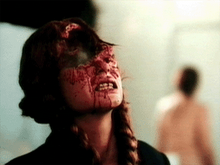By 1940, movies about a group of people trapped in an old dark house while a nefarious plan to dispatch one or several of them to gain an inheritance or continue a lucrative grift were a dime a dozen (or 30 dimes a dozen, to use 1940's average movie ticket price), but You'll Find Out manages to inject some pep in the step of the creaky old story by giving it the ol' showbiz razzle dazzle. We're talking horror, comedy, musical numbers, a dog with a man's haircut, and an exciting cast full of weirdos. The couple at the story's center are a pair of milquetoast snoozes, but it doesn't really matter because everything else going on around them is so much fun. I had a great time with this now-obscure oddity.
The second of director David Butler's three movies featuring conductor/bandleader Kay Kyser and his big band, You'll Find Out opens with Kyser and his band, the Kollege of Musical Knowledge, recording their then-popular weekly radio show in front of a live New York audience. The show was a mixture of musical numbers, comedy skits, and quizzes, and we see much of this show (with actors Jeff Corey and Mary Bovard playing themselves) interspersed with comedic vignettes of people in the city listening to it (a cab driver, an old guy in a tenement apartment, a mother taking care of a toddler). It's fascinating stuff if you're interested in showbiz and radio history.
The show's producer, Chuck Deems (Dennis O'Keefe), is feeling good. His high society fiancée, Janis Bellacrest (Helen Parrish), is back in town after three years away at finishing school (barf), and the couple can now get married. The Bellacrests are one of the 400, the list of New York Gilded Age high society families (double barf). Unfortunately, the movie is not about the brutal slaughter of these 400 fat cat bloodsucking parasite dynasties. It's the evening before Janis's 21st birthday, and she's throwing a shindig at the spooky Bellacrest mansion in the nearby countryside after the radio show finishes up, with Kyser and his band supplying the entertainment. Chuck and Janis are a total bore, but they're merely the excuse to get most of our large ensemble to the old dark house.
On the street outside the radio studio, a car nearly rams into Janis. It's the third near-fatal accident for her this week, so she finally recognizes a pattern and lets Chuck know. He does what most men in these movies do after a woman tells them some shit is going down. He says it's all in her imagination, and she needs to relax. Everyone shakes off the near-smushing of Janis, and Kyser's tour bus delivers the whole party-bound gang to the spooky mansion, which is only accessible by a single bridge.
The mansion is even spookier on the inside. Janis's late father collected all kinds of ghoulish artifacts and deadly weapons of murder (a poison blow-dart gun is given special prominence), and the place is jam-packed with them. (Unfortunately, we get some casual racism here about African art objects and the Bellacrest patriarch being murdered by a "savage" while "collecting" said artifacts. Fortunately, it's a pretty minor part of the film.) When Janis's aunt Margo (Alma Kruger) makes an appearance, the old woman seems whacked out of her gourd and pulls Kyser aside to tell him the dead have been speaking to her. We also meet the family attorney, Spencer Mainwaring (Boris Karloff), who is now a prominent judge. Mainwaring lays it on like he's a nice guy, but Kyser gets bad vibes.
After the initial meet-and-greet and assignment of overnight rooms, the party gets hopping when a busload of high society young women arrive. Janis promises the ladies that a second busload of top college men, handpicked by her, will be appearing soon in response to their queries about the party's lack of beefcake (the mostly male musicians give each other the "what are we, chopped liver?" look), but a sudden storm and its attendant lightning take out the bridge before the fellas can make it to the party. A brief blackout follows, and another failed attempt on Janis's life ensues, noticed only by Kyser, who sees the blow dart stuck in the wall. When he tries to show Chuck, the dart is gone.
Power restored, the big band decides to cheer up the young women with a live performance from the ballroom. More musical numbers follow, including a showcase for the only woman in the group, Ginny Simms, and a goofy novelty number spotlighting the band's comic relief, Ish Kabibble (real name Merwyn Bogue), who seems like the prototype for Jim Carrey's hairstyle and comedic personality in Dumb and Dumber. Kabibble has a cute dog with the same haircut. Kabibble was a comedy star and cornet player for Kyser and a few other bandleaders in the '30s and '40s, but his comedic approach was polarizing. On an episode of All in the Family, Maude mentions in disgust that Archie Bunker is a big fan. I wish Kabibble no ill will, but I thought the dog had better comic timing. He was pretty good on the cornet, though.
After the band finishes their three-song set, with a break before the third song (1976 Ramones gigs were longer), Aunt Margo decides to hold a seance, facilitated by her personal guru and spirit guide Prince Saliano (Bela Lugosi). Saliano's seances are like Iron Maiden concerts compared to your usual crystal ball on a card table biz. We get two giant electricity-conducting metal balls on posts, floating objects, Saliano going into a trance, and the floating disembodied faces of people from the other side, speaking in a weird synthesized robo-voice, achieved through the use of early talk box, the Sonovox, which had been invented the previous year. (The Sonovox is also an integral part of the Kyser band's closing musical number, exchanging vocals with Simms.)
Our final major character arrives shortly before the seance, a professor named Karl Fenninger (Peter Lorre), invited by Janis to debunk or confirm Saliano's spiritualist schtick. Fenninger loves to smoke cigarettes while wearing a look of bemused disdain for his fellow human beings. (Personality-defining line of dialogue, delivered quietly to himself: "Why do I have to waste my time outwitting morons?") Even if this movie were a dud, it would've been worth watching just to see Lorre, Lugosi, and Karloff occupying the same space. I love these guys. This is surprisingly Lorre's only movie with Lugosi, by the way.
For the rest of the running time, we get double crosses, homicide attempts, hidden passageways, catacombs, slapstick, and more music. As someone who has had to expensively endure weeks of major plumbing work under my house (our '60s-built cast-iron pipes finally hit the end of their road), I'd really like to know how long it took to create these hidden passageways in the house and how much it cost. Most of it is a lot of fun (though the novelty song "The Bad Humor Man" commits sins against music and comedy); all of it is silly.
Butler, a silent film actor turned workaholic filmmaker-for-hire of studio B pictures who closed out his career by directing 50+ episodes of Leave It to Beaver and the Bobby Vee/Jackie DeShannon teenybopper movie C'mon, Let's Live a Little, handles the chaos of the film's huge cast and its multiple genres with skill. The movie never loses control or gets bogged down, and it remains lively and engaging throughout its running time. The dullsville couple at the center could have sunk this thing if they were the main focus, but, thankfully, the movie spends a lot more time with the band and the trio of charismatic villains. This movie should be better known. How many other horror/comedy/musicals starring Boris Karloff, Bela Lugosi, and Peter Lorre are there? That's right, none.














No comments:
Post a Comment